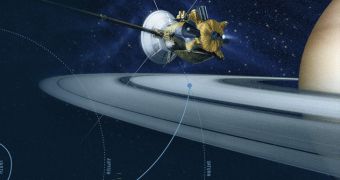It's been 15 years since the Cassini space probe was launched from Cape Canaveral on its way to one of the most beautiful planets in our Solar System, Saturn. NASA is celebrating the mission and its continued success in the best possible way, with an infographic.
Granted, unlike most of these, this one is quite informative on top of being, well, graphic. It tracks Cassini's 15-year history and highlights the greatest discoveries and moments.
Cassini has spent its last eight years circling around Saturn and its moons and it's been the source of some of the most spectacular images ever sent from space.
That said, out of the 300,000 images that Cassini shot and sent back, there were bound to be some really good ones.
But Cassini has done more than just revolutionize the space wallpaper industry, it sent back 444 GB of data that has been invaluable to scientists.
More than 2,500 science papers were written based on data sent back by the probe.
Cassini is feeling its age at this point, the white paint on its high-gain antenna has deteriorated a bit and its outer layers have been hit by plenty of fast moving micrometeorites by now, but the probe is doing well, all of this while consuming very little energy.
"As Cassini conducts the most in-depth survey of a giant planet to date, the spacecraft has been flying the most complex gravity-assisted trajectory ever attempted," NASA's Robert Mitchell, Cassini program manager at JPL, said.
"Each flyby of Titan, for example, is like threading the eye of the needle. And we've done it 87 times so far, with accuracies generally within about one mile [1.6 kilometers], and all controlled from Earth about one billion miles [1.5 billion kilometers] away," he added.
In fact, Cassini has plenty of work ahead of it. Currently, it's in its Cassini Solstice Mission phase that is scheduled to take until 2017.
Its mission has already been extended twice, once in 2008 and then in 2010. There's no reason to believe that, if Cassini is still up for it, its mission won't be extended even further.

 14 DAY TRIAL //
14 DAY TRIAL //